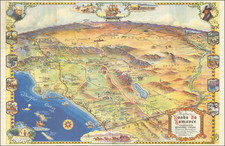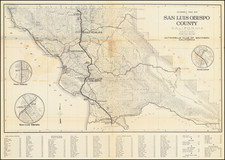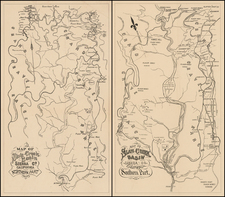An Extraordinary Pacific Northwest Railroad Rarity
Documenting The Progress of the Most Important Pacific Northwest Railroad
Fascinating large format map of the Oregon & California Railroad, likely published in late 1883 or early 1884, at a time when the railroad line had been successfully re-capitalized and was pushing south through Grant's Pass, but still pre-dating by 3 years the final connection of the line to the Central Pacific Railroad's line from California.
The history of the line is interwined with the remarkable development of the lumber industry in the Pacific Northwest, with the line serving as one of the primary arteries for the bringing timber from the interiors of Oregon and Washington to the saw mills and commercial centers of the Pacific Northweest.
The present map is both an extraordinarly rare artifact of the progress of the Oregon & California Railroad and documentation of its scandalous past. As with most of America's earliest western railroads, the line was to be funded in part by land sales, in this instance to individual settlers in the Willamette Valley and on south of Salem. However, the sale of the lands became a massive source of fraud, which resulted in criminal prosecutions which lasted until the early part of the 20th Century.
The map shows what appears to be the proposed route of the Oregon & California Railroad from Olympia, Washington and the Dwamish River area (Seattle), extending south to Vancouver, Washinton, on the north bank of the Columbia River. South of hte River, a solid brown line suggests that the Railroad line has been completed from Portland, Oregon south to the area south of Canyonville, terminating around Grant's Pass, before returning to a tentative route extending south between the Upper Klaimath Lake and Lower Klamath Lake.
The map is a remarkable amalgam of cartographic information. Overall, the map is very similar in coverage to the 1856 Preston's Sectional and County Map of Oregon and Washington . . . , and for the northern and southwestern portions of the this map, the maps are quite similar. However, for areas around thesouthern route of the Oregon & California Railroad from Portland to the Klamath Lakes area, the cartographic content is heavily revised.
While virtually unknown to bibliographers, this would seem to be a variant of the same map identified in John Howell Books Catalog 52, #370, as follows:
A map showing the route of the Oregon & California Railroad from the vicinity of Seattle (not named) south to the northern California border. The only completed section was from Portland to a point on Muddy Creek, north of Eugene, with another section to Canyon definitely located. Those routes from Seattle to Vancouver, W.T., and from Canyon south to the California border near Lower Klamath Lake had only undergone preliminary surveys.
The description above suggests that the Howell copy would have been an earlier state of the map, likely circa 1872 (see chronology of completion of the railroad line below).
History of the Oregon & California Railroad
The Oregon & California Railroad (O&C Railroad) is a fascinating case study in the complex interplay of government policy, economic ambition, and the westward expansion of the United States in the 19th century. This narrative begins in July 1866, when Congress passed the Oregon and California Railroad Act, a legislative effort aimed at encouraging the construction of a railroad from Portland, Oregon, to San Francisco, California. The act allocated 3,700,000 acres of land to facilitate this endeavor, to be distributed in 12,800-acre grants for each mile of track completed.
Construction and Development
Two rival entities, both named the Oregon Central Railroad, embarked on competing projects to construct the railroad, one on the west side and the other on the east side of the Willamette River. These ventures would later merge and reorganize as the Oregon and California Railroad. Following a 1869 Congressional amendment, the grants were to be sold to settlers in 160-acre parcels at $2.50 per acre, in a checkerboard pattern extending 20 miles on either side of the rail corridor.
Early Construction and Expansion
-
December 24, 1869: The first section of the O&C Railroad, under the name of the Oregon Central Rail Road (east side), was completed to New Era, 20.08 miles south of Portland.
-
September 27, 1870: The railroad reached Salem, marking a crucial step in linking Portland with the fertile Willamette Valley.
-
December 25, 1870: The expansion continued to Albany, further solidifying the railroad's presence in the valley.
-
October 15, 1871: Eugene was connected, extending the line significantly southward and enhancing the agricultural and timber regions' access to markets.
-
December 3, 1872: Roseburg was reached, but construction halted for nearly nine years, reflecting the financial and logistical challenges of the era.
Resumption and Completion
Throughout the 1870s and into the 1880s, the O&C Railroad spurred the development of key Oregon towns. Canby, Aurora, and Harrisburg emerged as vital nodes for freight and passenger traffic, while the expansion into the Umpqua Valley saw the establishment of towns such as Drain, Oakland, and Yoncalla. After 9 years, construction began again.
-
August 14, 1882: Construction resumed with the completion of the section to Myrtle Creek.
-
December 2, 1883: The railroad extended to Grants Pass, overcoming the geographical challenges posed by the rugged Oregon terrain.
-
May 4, 1884: Ashland was connected, marking the O&C Railroad's approach to the Oregon-California boundary.
-
June 1, 1887: The Central Pacific Railroad, building north from Red Bluff, California, reached the Oregon border, setting the stage for the final linkage.
-
December 17, 1887: The O&C, under lease to the Southern Pacific Company since July 1, completed the stretch north from the border to Ashland, finalizing the Siskiyou route and creating a continuous rail line from Portland, Oregon, to New Orleans, Louisiana.
Expansion and Fraud
The railroad's ambition culminated in its extension to California, reaching Ashland by May 4, 1884, and eventually connecting with the Central Pacific's northbound construction from Red Bluff, California, at the Oregon border on June 1, 1887. This completion marked a significant achievement, creating a continuous rail line from Portland, Oregon, to New Orleans, Louisiana, under the management of the Southern Pacific Company.
However, the O&C Railroad was also at the center of a significant land fraud scandal. Despite the intention for land to be sold to settlers, much of it was difficult to sell due to its rugged, forested nature. The railroad found it more profitable to sell larger plots to developers and timber companies. A scheme orchestrated by railroad officials involved hiring individuals to pose as settlers, purchase land at $2.50 per acre, and then sell it back to the railroad. This practice led to large-scale fraud, culminating in a 1904 investigation by The Oregonian, which revealed that more than 75% of the land sales had violated federal law.
Indictments and Legacy
The scandal led to nearly a hundred indictments between 1904 and 1910, implicating figures such as U.S. Senator John H. Mitchell, U.S. Representatives John N. Williamson and Binger Hermann, and U.S. Attorney John Hicklin Hall.
Rarity
The present map is extremely rare and apparently unknown to bibliographers such as Wheat and Streeter.
We note a single example offered for sale by John Howell Books in his famed catalog 52 (#370).
OCLC locates a single possible example at UC Berkeley (Bancroft Library).
The Bancroft holds a map of similar size and title which attributes (quite unlikely) to George Davidson, with a date of 1872. It is possible that this is a later edition of the same map, or that the Bancroft cataloging did not analyze the progress of the railroad line in order to arrive at a more accurate date.
Provenance: The present example was believed by the prior owner to have been purchased from John Howell Books in the early 1980s.









![[Drake's Bay to Fort Bragg] Bodega Head to Abalone Point From The Latest United States Government Charts . . .](https://storage.googleapis.com/raremaps/img/small/73078.jpg)
![[ Rare Early State! ] America's Greatest Scenic Asset The Columbia River Highway [cover title:] Portland Oregon featuring the Columbia River Highway](https://storage.googleapis.com/raremaps/img/small/77120.jpg)



![[Southern California Views] Delightful Southern California, The Land of Sunshine and Bloom](https://storage.googleapis.com/raremaps/img/small/74862.jpg)